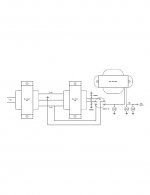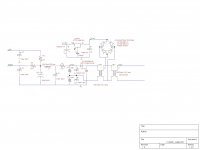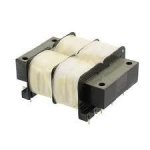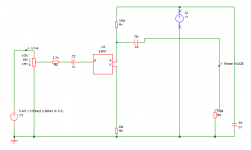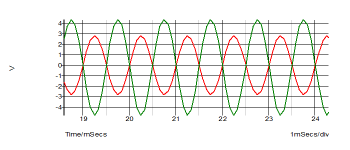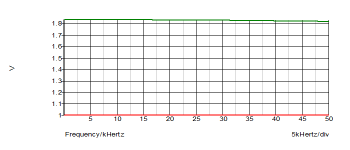The only thing is the isolation transformer I have was taken from a Variable frequency drive. The coils are about 12 gauge...the same on both sides...so I'm guessing that the amperage will be pretty high.
Shoog- The 7N7's are a med mu and are said to be somewhat noisy for small signals...however they run quieter at lower voltages. At 24V it sure sounds good...a bass guitar pluck or harp pluck goes through the air. Would increasing the B+ to 100V + cause more noise? Or am I misunderstanding something.
Shoog- The 7N7's are a med mu and are said to be somewhat noisy for small signals...however they run quieter at lower voltages. At 24V it sure sounds good...a bass guitar pluck or harp pluck goes through the air. Would increasing the B+ to 100V + cause more noise? Or am I misunderstanding something.
I just realized that all the capacitors I have are about 50V max. I have numerous 480u rated for 400V. I dont think it will be enough to smooth a power supply.
This seems to be getting bigger and more expensive...which is often necessary for sound.
I will have to decide to stay with what i have...or maybe go with a jfet if i am doing something wrong with the tube.
I should have mentioned that my source puts out more voltage than i need...so this might be considered a line stage...i tried a passive volume control...but i did not loke the results.
This seems to be getting bigger and more expensive...which is often necessary for sound.
I will have to decide to stay with what i have...or maybe go with a jfet if i am doing something wrong with the tube.
I should have mentioned that my source puts out more voltage than i need...so this might be considered a line stage...i tried a passive volume control...but i did not loke the results.
Not for a low current draw pre amp. You just use RC circuits, My pre uses a few 100u 250V capsI just realized that all the capacitors I have are about 50V max. I have numerous 480u rated for 400V. I dont think it will be enough to smooth a power supply.
This seems to be getting bigger and more expensive...which is often necessary for sound.
.
Here's the whole Power Supply...

And, don't laugh...The 6DJ8's Work Fine, with Plenty of Dynamics...One thing Tho...The 6DJ8 Heaters are fed from a 6v 2.5A DC Brick...
And, don't laugh...The 6DJ8's Work Fine, with Plenty of Dynamics...One thing Tho...The 6DJ8 Heaters are fed from a 6v 2.5A DC Brick...
Attachments
Last edited:
If the first transformer also feeds heaters, it needs to be larger than the second. Power calculations and such. Also for real headroom one might use the second transformer secondary in a voltage doubler circuit - thinking of countries where the mains is 110VAC.
This only feeds the Rectifier...
I get 140v B+ out of this...And, do you know that these are $12 Transformers, if you can find a Radio Shack anymore?
That's why you need to find a Good 6v DC Brick for the Heaters...
I get 140v B+ out of this...And, do you know that these are $12 Transformers, if you can find a Radio Shack anymore?
That's why you need to find a Good 6v DC Brick for the Heaters...
Last edited:
Cannot comment on the 7N7 other than to say that it wasn't designed for 24v duty.
I am a big fan of P and U designation tubes as they are generally easier to heat with salvaged transformers and they are generally much cheaper than there E type brothers.
Shoog
I am a big fan of P and U designation tubes as they are generally easier to heat with salvaged transformers and they are generally much cheaper than there E type brothers.
Shoog
Last edited:
If you live in US/Canada, another trick you can do is to buy an ordinary low voltage transformer that has a dual primary (0-120, 0-120), but only drive one of the windings. You can then use the other winding for the high voltage supply, and the low voltage winding for the heaters. The total VA rating needs to be shared between the windings, of course.

After rectification you should get about 140Vdc under load, which is enough for ECC88/6DJ8, and many other valves too, if you're crafty.

After rectification you should get about 140Vdc under load, which is enough for ECC88/6DJ8, and many other valves too, if you're crafty.
Last edited:
Is it less expensive for us in the US to do this, than to get a Triad or even Hammond?
I looked up some prices and it seems close.. but I didn't spend much time on it. You can find 120-240v tx's for $20-$30.
I looked up some prices and it seems close.. but I didn't spend much time on it. You can find 120-240v tx's for $20-$30.
If you live in US/Canada, another trick you can do is to buy an ordinary low voltage transformer that has a dual primary (0-120, 0-120), but only drive one of the windings. You can then use the other winding for the high voltage supply, and the low voltage winding for the heaters. The total VA rating needs to be shared between the windings, of course.

After rectification you should get about 140Vdc under load, which is enough for ECC88/6DJ8, and many other valves too, if you're crafty.
However, there perhaps needs to be some caution here. Depending upon the design and construction of the transformer, the insulation between the two primary windings may not be to the same standard as that which may exist between the primaries and the original secondary. The effect of using one of the primaries as a secondary can be to significantly reduce the level of isolation between the mains and the load from both a safety and an interference standpoint. While this approach would obviously work technically, personally I would not recommend it for general use.
MelB's approach of using two cascaded transformers is much better in this respect.
Last edited:
Here is a very cool looking little transformer on ebay right now! Should be 120 and 12 v secondaries.
HAMMOND - 262G12 - Transformer NOS | eBay
Specs close to 262F12 I would assume:
Hammond Mfg. - "Classic" Low Power/Bias Transformer - (261-262 Series)
If I did not already have the transformer I would get a proper tube transformer as it will be more efficient easier to wire and look better. And this ebay one is ultra cute!
HAMMOND - 262G12 - Transformer NOS | eBay
Specs close to 262F12 I would assume:
Hammond Mfg. - "Classic" Low Power/Bias Transformer - (261-262 Series)
If I did not already have the transformer I would get a proper tube transformer as it will be more efficient easier to wire and look better. And this ebay one is ultra cute!
Thank you all for your suggestions.
I am taking them into consideration...Tubes just sound so much better so no Jfet option.
Here is the circuit I am running...it is very simple...but it works.
It is running at 60% volume which is loud enough to fill the house.
In simulation I can get almost full volume without clipping on 48V
140V puts me at +/- 8V without clipping.
The Dynakit ST-35 needs 1V to max it out at 17.8V output.



I am taking them into consideration...Tubes just sound so much better so no Jfet option.
Here is the circuit I am running...it is very simple...but it works.
It is running at 60% volume which is loud enough to fill the house.
In simulation I can get almost full volume without clipping on 48V
140V puts me at +/- 8V without clipping.
The Dynakit ST-35 needs 1V to max it out at 17.8V output.
However, there perhaps needs to be some caution here. Depending upon the design and construction of the transformer, the insulation between the two primary windings may not be to the same standard as that which may exist between the primaries and the original secondary.
If the two 117V primaries are wound on separate bobbins then the isolation would be excellent, to "HiPot" specs, 1.4KVDC isolation. Like transformers like this
These transformers resemble toroids, and toroid transformers really want you to use bridge rectifiers to keep DC bias out of the windings.
Attachments
Last edited:
If the two 117V primaries are wound on separate bobbins then the isolation would be excellent, to "HiPot" specs, 1.4KVDC isolation.
Indeed, that is quite probably true. But the vast majority of mains transformers with two primary windings are not like that - hence the advice that I gave.
I just got this for $10 at the electronic surplus store.
It is a constant voltage transformer. Will this transformer work for audio?
The schematic on the front shows browns as output with a 2mfd capacitor hooked up to the reds.
This gives the browns 118vac output at 175mv
I hooked it up and with a 0.96u capacitor connected to the red gives me 100 vac output from the browns. If I increase the capacitor rating the transformer buzzes like a bee on steroids.
With nothing connected I get 63vac from the browns and 186vac from the reds.
Would it be ok to use just the reds? It will not be used to drive the heaters.
It is a constant voltage transformer. Will this transformer work for audio?
The schematic on the front shows browns as output with a 2mfd capacitor hooked up to the reds.
This gives the browns 118vac output at 175mv
I hooked it up and with a 0.96u capacitor connected to the red gives me 100 vac output from the browns. If I increase the capacitor rating the transformer buzzes like a bee on steroids.
With nothing connected I get 63vac from the browns and 186vac from the reds.
Would it be ok to use just the reds? It will not be used to drive the heaters.
Attachments
Here's the circuit- take two
Sorry about any image problems on my previous post...
Here is the circuit I am doing...it sounds good...
My tube Dynakit ST-35 maxes out at 17.8 watts with 1V input. It has 500K input impedance.
I am using BA A100's 90db sensitivity.
In this schematic I have the volume pot set at 60%...enough to fill the duplex to "turn it down!" levels.
Its running off of 24V in this schematic...48V runs clean to 95% for the volume setting.
Sorry about any image problems on my previous post...
Here is the circuit I am doing...it sounds good...
My tube Dynakit ST-35 maxes out at 17.8 watts with 1V input. It has 500K input impedance.
I am using BA A100's 90db sensitivity.
In this schematic I have the volume pot set at 60%...enough to fill the duplex to "turn it down!" levels.
Its running off of 24V in this schematic...48V runs clean to 95% for the volume setting.
Attachments
Indeed, that is quite probably true. But the vast majority of mains transformers with two primary windings are not like that - hence the advice that I gave.
I agree, as the transformers that have both windings on the same bobbin I wouldn't trust to have sufficient isolation either.
I agree, as the transformers that have both windings on the same bobbin I wouldn't trust to have sufficient isolation either.
Assuming it is hi-pot tested, the two primary windings will at least withstand half the hi-pot test between each other, so it's not something I would ever worry about.
- Status
- Not open for further replies.
- Home
- Amplifiers
- Tubes / Valves
- Low voltage vs. High Voltage Preamp.
